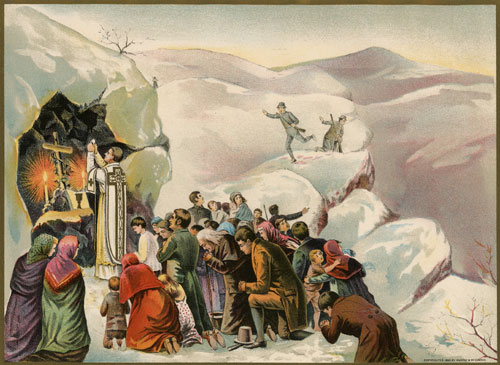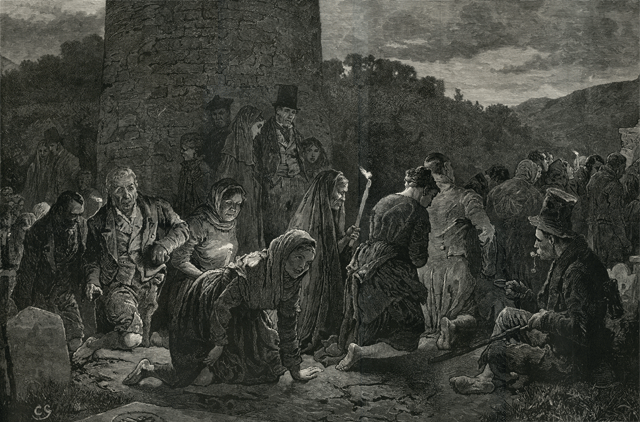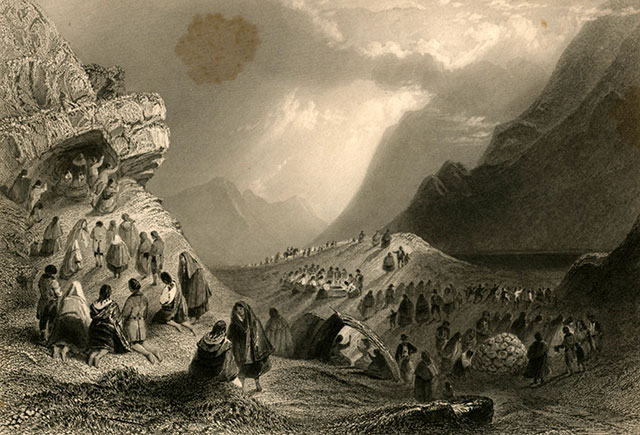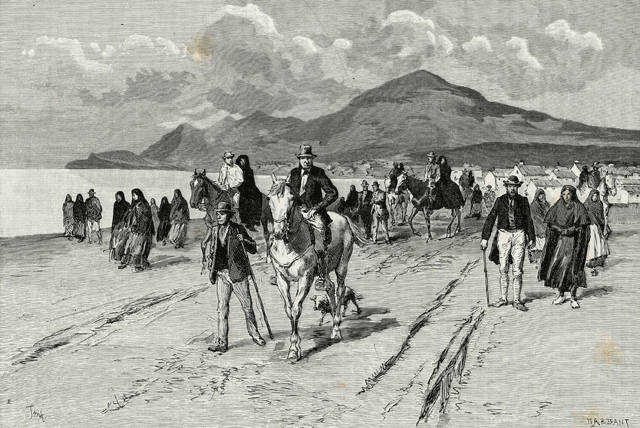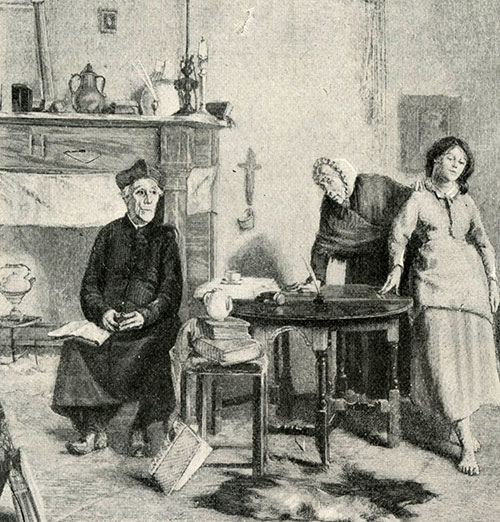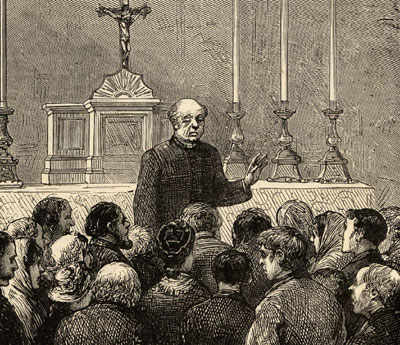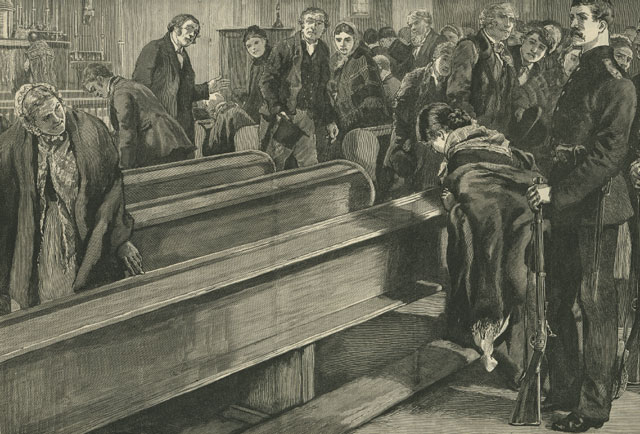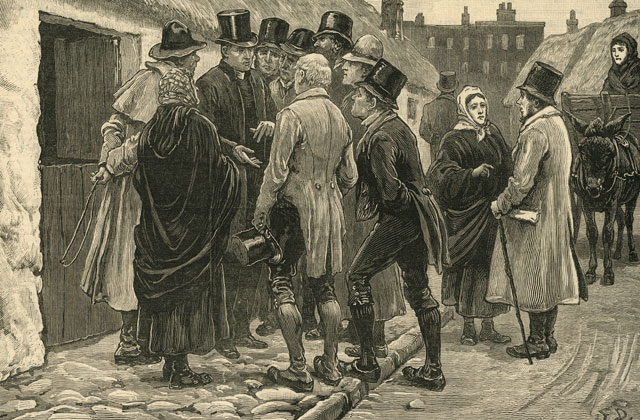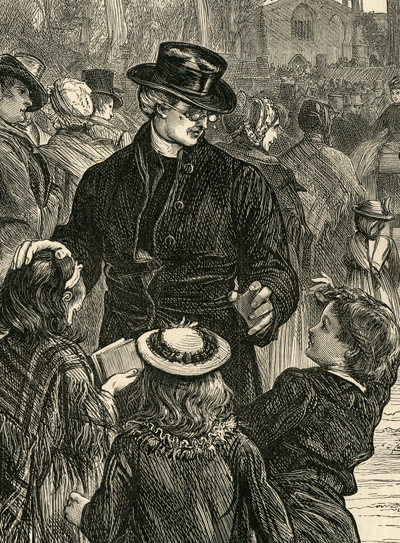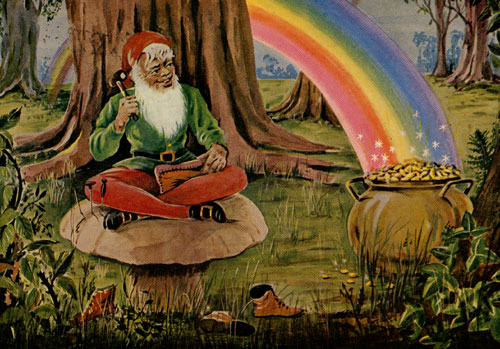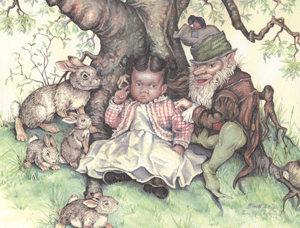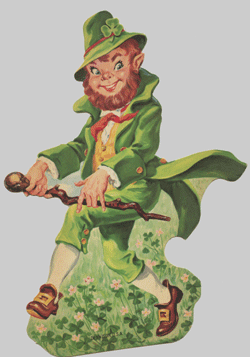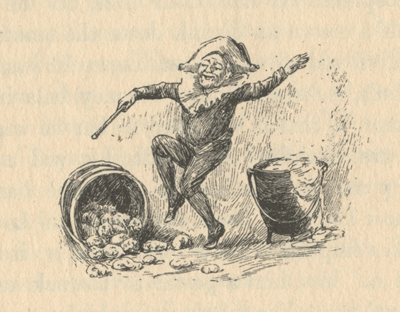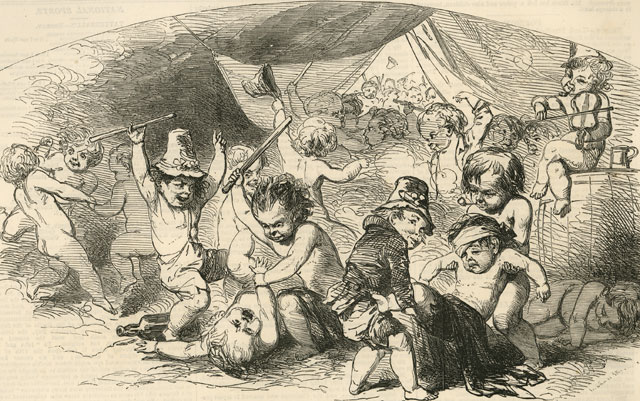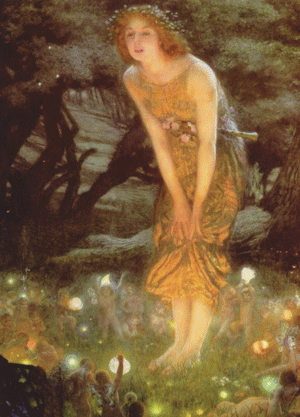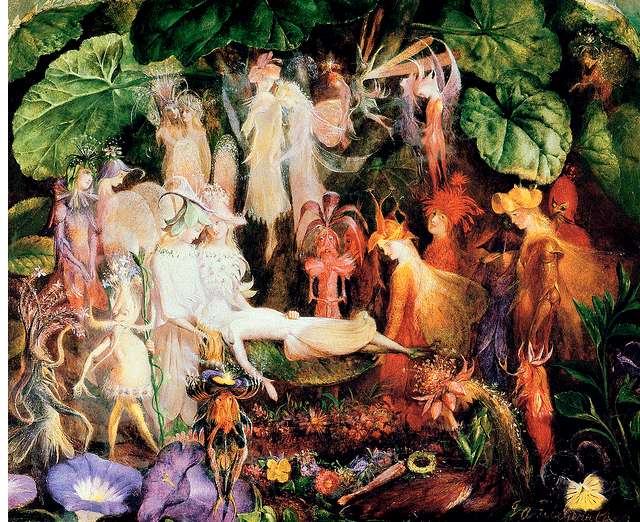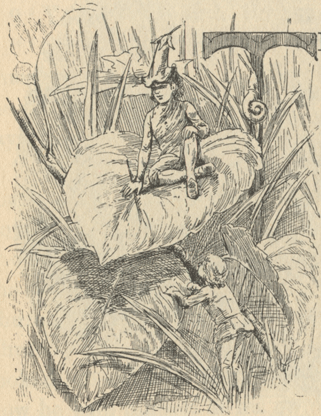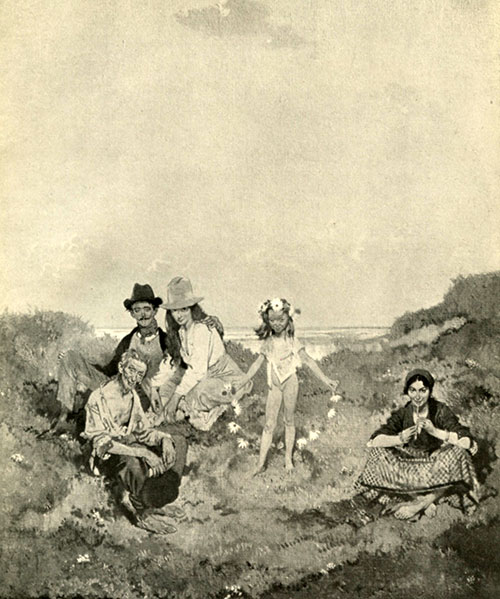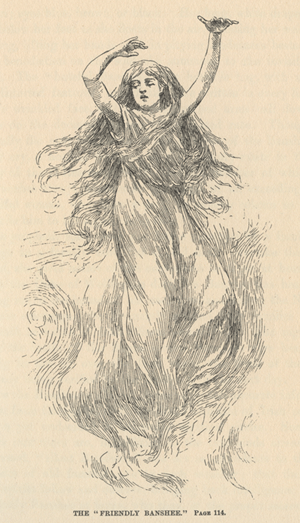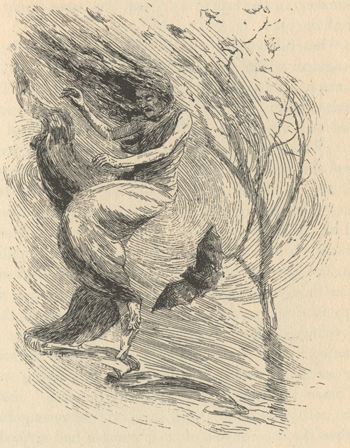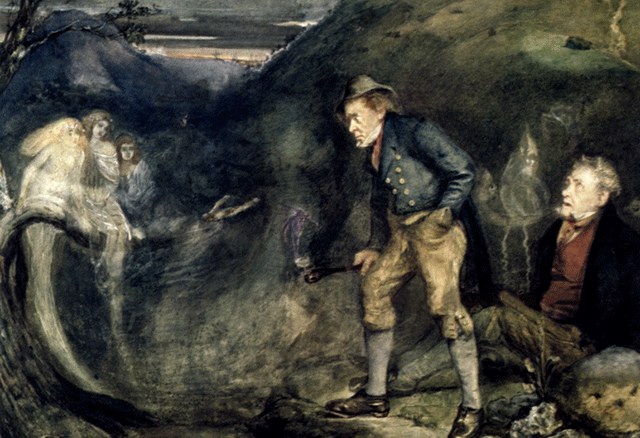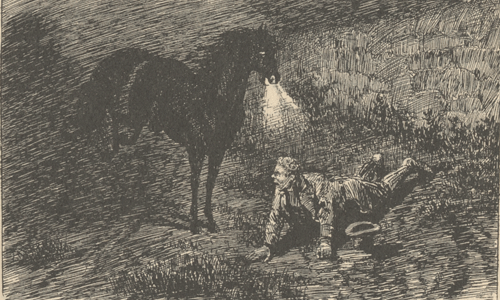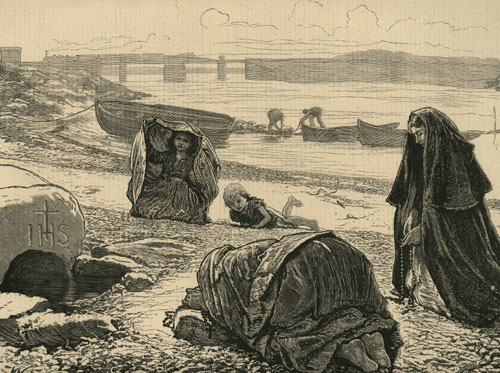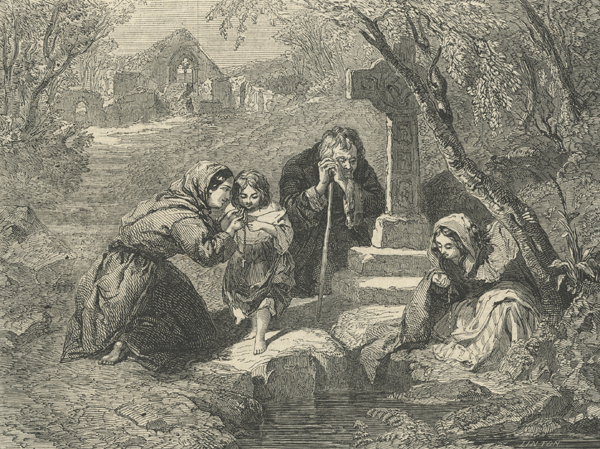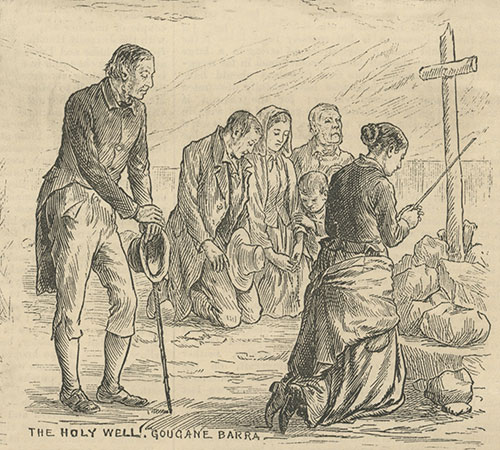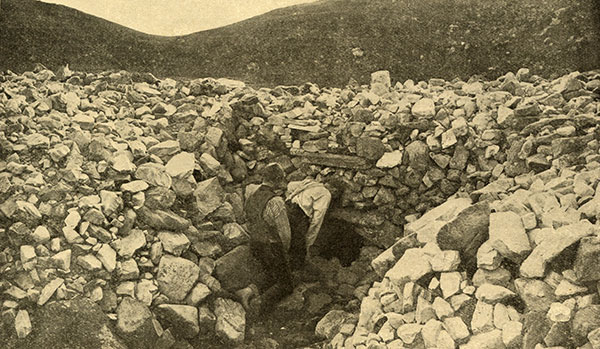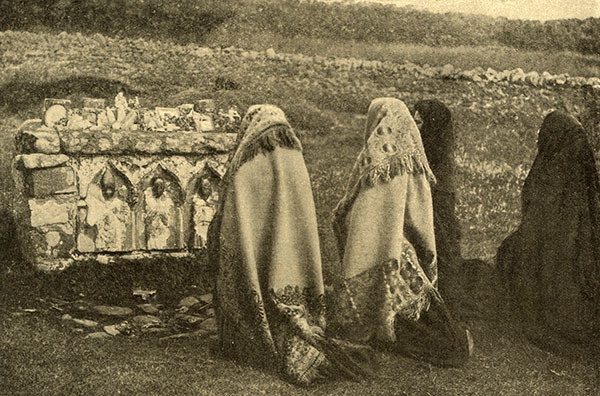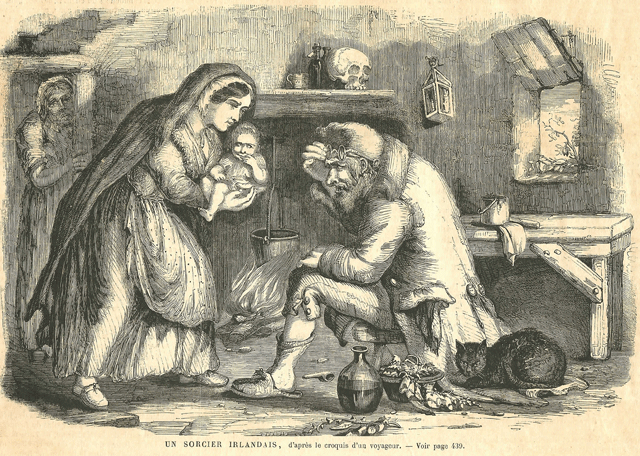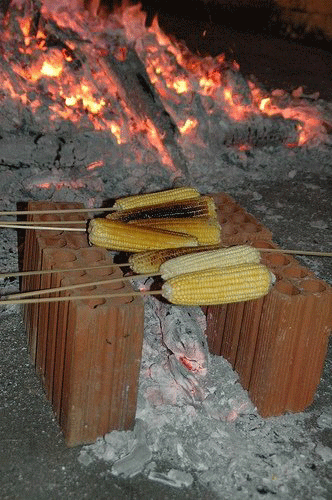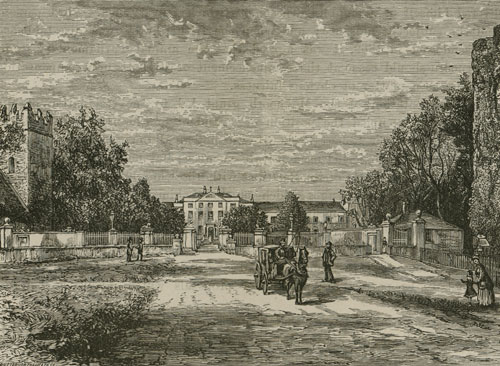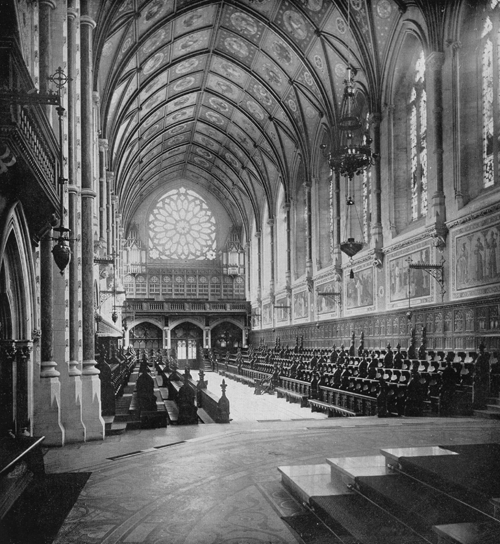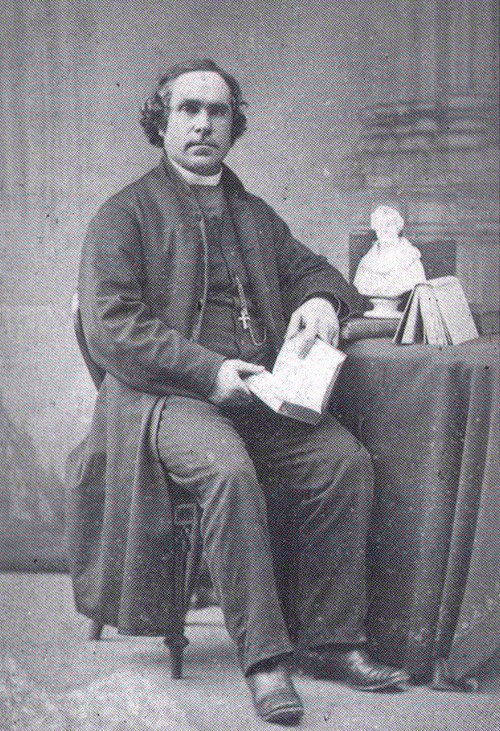Ballinrobe Roman Catholic Curate (a member of the clergy engaged as assistant to
the parish priest.)
Father Conway was the "minister" to both Ballinrobe and Partry for a number
of years. He was responsible, after long negotiations with a local landlord,
Colonel Knox, in obtaining permission to build St. Mary's Catholic church
on Main Street in Ballinrobe. Construction of the church stated in 1853.
Peter Conway was born c. 1814, place unknown but most likely near Westport or Ballinrobe.
He went to Maynooth College in 1835 and was ordained in 1841. During the famine years he was in
Partry where he became friendly with George Henry Moore who was a local landlord and lived at
Moorehall. Conway and Moore built a monastery at Tourmakeady.
Father Peter Conway came to Ballinrobe as a curate in 1847 when he was 28 years old.
He had already overseen the building of three churches at: Partry (where he was from 1843-1847),
Ballinfad and Carna (He had been curate at Roundstone in Connamarra).
Less than a year after his arrival in Ballinrobe he negotiated the lease of the land for the
site of the present St Mary's church.
Conway was a committed church builder who later built churches in Claran
and Headford. All the churches he built were dedicated to St Mary.
When Conway set about to build the church in Ballinrobe there was already a church
on Partry road that dated from 1828 to 1848.
Why was a new church necessary in Ballinrobe?
Some have suggested that Conway though the Catholic Church should be in the center of
town for greater physiological impact. One wonders why something was not done with another
church structure that already existed, namely to rebuild the old Augustine Chapel on Abbey Street.
The fact that he built a church in every parish he was connected to regardless of need
seems a little obsessive. With indications of his concern for education, why did he
not turn his energies to schools instead of churches?
The records for the parish start with the with the arrival of Father Conway.
The records appear to have been poorly kept in the first few years.
There is a four-year break in the records from 1856 and 1860.
Father Conway made several notations in the margins and end pages of
the parish record between 1848 and 1854.
Among the notations in the parish register is a list of famine victims.
The one page entry is very hard to read and the left margin, which
includes the names of the townlands, is torn so only the end of the names
of the two hamlets can be read.
The entry reads,
Registry , a list of those who
died since the famine
started in Ballinrobe
taken by me at me the
stations of confession 1848.
--loimermine Village
Bridget Flanely
W. MacCia
Patt Conwey
James Conduday
Mary Conduday
James Walsh
Bridget Walsh
David Walsh
Wm Henely
Catherine Henely
Catherine Hession
--ern and Thane (?) Park
James Walsh
Mary Walsh
Thomas Walsh, junior
Bridget Nally
William Meghan
Mary Meghan
John Murphy
Patt (cant read)
Thomas Do (this stands for ditto)
Cath Mac Hugh, poor
James Horan
Mary Gibbons
Teachy Malloy
Margaret Do
Owen Sweeney
Mary Do
James Henley
Margaret Do."
Although this entry was not signed, I assume that "me" was Father Conway
Another notation in the records was entered in 1849. It reads
"Left home for England and France today, the 4th
of October 1849 not having settled my accounts the (can't read)
Morris* being in my debt"
This entry was not signed. However, based on the date I assume that it was made
by Father Conway. *John Morris was the parish priest in 1849.
An entry in 1850 reads,
"The Rev. W Hardiman entered Ballinrobe Sunday the
13th of October the feast of the dedication of the Church of Ireland 1850".
Based on the date, I assume that Father Conway made the entry.
An entry in 1854 signed Conway reads,
"Regreted (sic) very much being under the harmful of necessity
of disobeying
the orders of the Revd Hardiman who directed me a few day
since not to baptize unle--- the font I could not do so in the present instance as had
no key- no candle- no basin-sent a messenger over the town for the girl who
keeps the key of the sacristy font. Conway
The Bridge article puts forth the idea that Father Conway was a great friend of
Archbishop John McHale and that the idea of building the new churches was most likely McHale's.
Rumor had it that in parishes where McHale could not control the parish priest he sent in
young curates to push his own agenda.
Conway was concerned with uplifting Catholics socially and in giving them
self-confidence. There are indications that he regarded himself as the people's social leader.
He liked the idea of being on an equal footing with the Protestants and sought to
emulate their life styles. Among other things Father Conway had his own monogrammed silver.
He maintained his own residence, as did Father Hardiman, the parish priest.
Father Conway considered himself a political activist. Among other things, he wrote
letters to local papers protesting the treatment of tenants who were evicted by Lord Lucan.
The foundation stone for St. Mary's Catholic Church in Ballinrobe was laid by
Archbishop John Mc Hale in May 1849 in the middle of the worst years of the famine.
Was this perhaps an effort to give employment to the local population?
"a reference in 1849 says that £ 25 a week in all was paid to workmen
at the church and favorable comparison is made with the money available on the famine relief
work"
Clearly the community was not up to such a project when there were so many hardships facing
the local population due to the famine and its after effects.
The actual building of the church took 15 years. There are indications that there
were several changes in plans: "The present church is built partly on the
lands obtained by the 1848 lease and partly on the land not obtained until 1853".
The church was dedicated on Pentecost Sunday 24th May 1863.
Father Conway had left the parish five years before and gone to be the parish priest in
Headford where he proceeded to build a parish church which was dedicated in June 1863
just a short while after the Ballinrobe church.
The Ballinrobe church as dedicated in 1863 did not contain the transepts and the
spire and was smaller than the current size.
The stone of the older part of the church is smooth and the additions are rough cut.
Much of the above information was taken from an article written by James Kierans in
The Bridge, circa 1977. Copies of pages 1 through 47 were emailed to me by John Doherty
in October 2005.
Peter Conway's Accusations against the Ballinrobe Workhouse,
1849 January 24, 1849
While curate in Ballinrobe Peter Conway swore several charges of murder and misconduct against Mr. Murphy, the master of the Ballinrobe workhouse.
One case was of a seven year old pauper child who was "seized suddenly, on the 31 of
May last, with bronchitis and was taken to hospital, and died same night". In his defense
Murphy "met this imputation in the most practical and unanswerable manner- he
produced the murdered boy in question "in rude health'".
Next Conway took up the case of Martin Casey. Casey had spent a few days in the workhouse and then apparently tired to escape with a new shirt that belonged to the Poor Union. His attempt to scale the walls of the workhouse was thwarted by some fellow inmates and he was put in the refractory cell, which he called the black hole. He then claimed that someone threw a rock in the widow and hit him on the head. Casey somehow made his getaway from the workhouse and found Patrick Conway. Conway led
"an infuriated mob against the workhouse, are-in-arm with one Martin Casey,
a pauper, who was covered with blood, said to be welling from wounds inflicted
on him in the cells of the Ballinrobe workhouse from which he had just escaped.
The military were turned out, the riot quelled; Martin Casey caught and
examined by a medical man"
Casey was apparently an Irish speaker as the investigator, Dr. Dempster, needed an interpreter to question the him.
Dempster concluded that Casey was lying because among other things there was no way a rock could have been thrown into the refractory window and stated further
"I saw that there was no blood on the shirt collar of Casey, not any on his coat when
he was brought into my office; and being suspicious of the case altogether I thought he
was not injured at all, and having heard him say it was in the black-hole he got the
blow from the stone confirmed me that I was correct. I had his head examined in presence
of Mr. Maytyn, by a medical officer of the army who came into my office, who
washed of the blood, and there was not even an abrasion of the skin-no wound- nor cut
or mark even- the man's face had been smeared with blood for effect before the mob."
The conclusion of the case was that without Conway's interference "They should not have thought
of accusing the master".
The English press stated that Conway made this accusations in opposition to the
New Poor Law whose agent, Murphy, did his duty
"so firmly, so intelligently, so honestly
and so humanely that he secured to himself the enmity of all who were oppose to the
success of the New Poor Law, and amongst them, the Rev. P. Conway"
Conway made other accusations against Murphy to the point that Murphy was thrown into
prison, tried and eventually "triumphantly acquitted".
If the events reported in the English press are correct, why did Conway take on these cases?
The situation with Casey is almost farcical. Was Conway duped? Did he take on other cases that had actual merit and only these (which could be easily ridiculed) received press coverage? How bad was the Ballinrobe workhouse? Was this an attempt to reform the workhouse? Was this a personal vendetta against Murphy?
Information from Palmer's Full Text Online sent to me courtesy of John Dohery, January 2006.
See Famine
for more details.
Disruption of the Mass by Military Officers and Conway's Response,
October 5, 1852
While still the Curate of Ballinrobe, Peter Conway had a confrontation in church and later in the press with officers from the local military barracks.
Some of the servicemen stationed in Ballinrobe were Roman Catholic. When they attended mass they were accompanied by a superior officer who was not Roman Catholic. There were several instances when officers rounded up their troops in the middle of mass and made them leave the church causing disruption to the service.
Conway viewed this as harassment.
However, part of the issue appears to have been that Conway sometimes spoke in Irish which the English officers did not understand. The officers suspected that Conway may have been using Irish to expound on issues of a political nature (Priests were not allowed to preach politics from the pulpit.).
Conway wrote a letter to the Tuam Herald complaining of the situation and stating that in the future some restrictions would be placed on the officer who accompanied the men to mass. Some posturing occurred on both sides and then the matter appears to have settled down.
As part of testimony taken from one of the officers in The Calvary Barracks the following
statement was made,
(Mr. Conway) announced to the congregation that if there should be any
dying calls during the ensuing week from the poor house or the town, the people
should call early in the day, as he would be among the country portion of the flock
getting their offerings"
Does this mean he was going to make monetary collection from the local peasants?
Information from Palmer's Full Text Online sent to me courtesy of John Dohery, January 2006.
Trial of Father Peter Conway on five counts connected with
the parliamentary elections of 1857, 22 February 1858
In the 1857 Parliamentary election in Mayo there were three candidates for two positions: Colonel Higgins of Glencorrib, George Henry Moore of Ballinrobe and Captain Palmer.
Moore was already a member of the parliament and was the most popular candidate with the people.
Higgins had also already served in parliament. However, both clergy and laity of Mayo accused him of betraying his pledge to the people.
Captain Palmer was new to politics and although his father had a bad reputation during the famine he was not unpopular.
Moore and Palmer won.
Higgins lodged an objection based on intimidation and interference from the clergy.
A parliamentary committee found in favor of Higgins.
George Moore was forced to give up his seat.
It took eleven years before Moore could regain his seat.
This was a severe blow to the peasants of County Mayo.
Peter Conway was one of the clergy accused of intimidating his flock.
He was accused on five counts of events relating to the election :
- Intimidating his parishioners in the chapel by bringing a curse from God on those who
would vote for Colonel Higgins
- Inciting the crowd to riot
- Abduction of voters
- Assault on Colonel Higgins where Conway was among the assailants
- Intimidation of Mister Burke of Ower
Testimony on three of the charges was covered in the article.
-
Intimidation of voters
On Palm Sunday 1857 Conway told the congregation that it was necessary to keep the peace and be
"careful" of Captain Higgins (who was then high Sheriff) as the keeper of the law.
He then referred to the fact that some Roman Catholic landlords kept their Catholic
tenants from mass that day. This was a serious matter and he hoped the curse of
God did not fall on them for "acting so". He spoke of "voters who were locked up like
slaves and prevented from attending mass". The discrepancy was, did he state that he hoped
"the curse of God would not fall upon the men who kept the people away
from mass" or that he hoped that the curse of God would
fall on those who voted for Colonel Higgins.
- Inciting to Riot
After the service Conway spoke to the crowds in a lane where he begged them
not to break the peace because to so would only strengthen "the hands of the enemy".
Witnesses said that Conway told the crowd that they could show their displeasure by
shouting but advised them not to throw stones or "commit a breach of the peace".
Conway apparently spoke in English and Irish.
- Assault on Colonel Higgins
A mob met Colonel Higgins carriage near Cong. Witnesses for Conway testified that he said "Stop,
be easy boys" and "Boys be quite and peaceable". Witnesses against stated that he said "At them,
boys".
No real mentions was made in the article about the abduction of voters. It sounds like the landlords who
would not permit their tenants
from going to mass were more the abductors than Conway.
Mr. Burke is mentioned several times but there is not enough real information to determine what the story was in connection to the intimidation of Mr. Burke. It sound like Burke pointed a pistol at Conway not the other way round.
By the time the case came to trial "A comparatively thin attendance"
showed that the "interest in the result of this famous case" was dying out.
There was much conflict of testimony and in the end the jury could not agree
on anything as so were dismissed.
Information from Palmer's Full Text Online sent to me courtesy of John Dohery, January 2006.
Patrick Conway was tried in Dublin in March 1858. The trial was covered in part by the
Brooklyn Eagle, Brooklyn, New York.
He was described as "a young man, of most mild and
gentlemanly look and demeanor." 34 counts were brought, 20 of which charged Conway with intimidation and violence.
Conway pleaded "Not guilty" to all counts.
Conway was said to have used "strong language" against the candidate Higgins -
saying he was a "consummate scoundrel" and that any man who voted for him would be cursed by God. It was testified that
Conway knelt with
uncovered head and
addressed the
people in the Irish language. A witness who was said to have understood Conway's words claimed he said, "My
curse as a priest - the curse of God - the curse of the Church and the people be upon you if you vote for Col.
Higgins." It was stated that he repeated the curse more than once. Further it was stated that Conway "rode in
amongst the voters very furiously" and called the witness "ill
names".
Peter Conway, Parish Priest Headford, Co. Galway
Headford is located south of Shrule between Ballinrobe and Galway city.
The following information on Peter Conway is from
Headford, County Galway 1775-1901, by Gerardine Candon (2003).
By 1861 (when he applied to the Commission of Education for aid to build a
local school) Fr. Conway was the parish priest in Headford, County Galway.
A new Catholic church was build in Headford on land donated by the St George
family (the leading landlords in the area) The foundation stone was lain on June 7, 1863.
There was an imposing opening ceremony attended by Archbishop McHale and other
dignitaries and crowds of people from, Taum, Galway town and Ballinrobe.
Mc Hale spoke in Irish. "A sumptuous dinner was laid on for Fr Conway's guests."
"The role of hero is reserved for Fr Conway. His journey to America
to raise money for the church turns out to be his opportunity to save his fellow
passengers lives from mortal danger"
About his personal character she quotes Henry Coulter:
"[He]....is well known to be an active, zealous, and benevolent man. His charity is
unbounded, but his best friends are of the opinion that his zeal sometimes
outruns his discretion. His strong feeling and fervid imagination have led him
to make statements as t the extent of distress in Headford, which he undoubtedly
believes to be accurate, but which persons equally well informed and equally truthful
regard as exaggerated. (Henry Coulter)"
Peter Conway, Last Will and Testament
On October 23 1865 Peter Conway who was then the parish priest at Claran, Headford wrote his
last will and testament. I find it a very interesting document for a number of reasons not the
least to which is the disparity between his "effects" and those of his parishioners.
The bulk of his estate were left to the Arch-bishop, John Mc Hale of Tuam and his nephew, the
Reverent Thomas Mc Hale, D. D., Irish College, Paris for the purpose of building
a convent school in Headford "to educate the poor children".
The "effects" to be left for the building of the convent were: a house in Claran, furniture, crops, fifty-one sheep, six head of cattle, one horse, and three young horses, three pigs, a house in Ballinrobe (with an income of £10 per annum) a house in Partry Ballinrobe (with an income of £5 per annum).
Out of this estate the nuns were to take £50 for a memorial to
"commemorate the life
and reign of one of the greatest of priests, and the most zealous and humble of Bishops, namely
John McHale, which monument is to be erected on the ground of the Ballinrobe church".
In addition he left the following objects to the sons of his "valued friend, George Henry Moore":
his watch, his gun and his gold cross.
He left his silver plate to Richard St George of Headford Castle who he respected and esteemed
dearly. In the event that St George did not want the silver plate he had the option of taking
two of the young horses. In which case the plate would be given to Conway's sister, Mrs. Regan of Ballinrobe and the third young horse was to be given to the Arch Bishop of Tuam for his personal use.
Mrs. Regan may have sincerely hoped that St George did not take the silver plate option as
otherwise she got nothing but prayers and blessings as Conway designated:
"To all my brothers and sisters, and other relatives, I leave my blessing and
pray they may work out their salvation and an honest industrious livelihood by the sweat
of their brows with perseverance, energy, and industry, never forgetting their duties to God,
and their oppressed country, namely Ireland."
Mrs. William Murray, Galway was remembered with a mantel clock. Conway's landlord, John Brown, was
remembered with a "copy of the lives of the saints and the red heifer". His housekeeper,
Mrs. Ansboro, got blessings, his servant, Mary Gibbons fared better with £10. The clerk,
Tom Walsh, got some used clothes that he was to share with Conway's labourer, G. H. Moore.
Peter Conway died June 22, 1872 age 58 of an illness he may have
contracted while visiting the sick.
Conway (Reverend) Peter - probate effects under £1,000 15 August
(with one Codicil) of the
Reverend Peter Conway late of Headford County, Galway P.P.* deceased
who died 22 June 1872 at same place proved at Taum of the oath of the
Reverend Thomas M'Hale of the Irish College Paris D. D. on of the Executors
*Parish Priest
Some Thoughts and Questions
While he was called an activist priest, from today's vantage point is very hard to understand
some of his actions.
When so many were dying of hunger and suffering from extreme poverty, why was one of his
major aims to keep building churches? Ballinrobe already had a church when he arrived
and proposed building another.
While so many Roman Catholic children were illiterate with little or no chance of social
advancement, he would rather see them remain so than be taught by Protestant Mission Schools
and/or the National Schools,
because the Catholic Church could not support their own schools.
When tenants were evicted by Lord Lucan at least 80 families went to Conway seeking aid in finding shelter. He told them to return to their houses and
"endeavour to shelter themselves and bear patiently with their cruel treatment".
While he did
leave money in his will for a school for the "poor children"
what was the purpose of giving watches, horses, and silver-plate to those who certainly did not need
it?
Along the same lines, if Mc Hale was indeed a man worthy to be remembered by his deeds might the £50 been better spent on the education of the
"poor children" that on a piece of stone?
The poor labour and other servants who most likely could have used some cash, got only
used clothes and blessings.
His siblings, who may have made their own sacrifices so that Peter could go to school to
become a priest, were told to work out their salvation by the sweat of their brow.
Even more to the point, what was a curate (the assistant to the parish priest) in a desperately poor part of the world
doing with silverplate? How did he come by the money for three houses and a gentleman's allotment of livestock?
The will of Peter Conway was in The Bridge, December 1772.
A copy of which were emailed to me by John Doherty in December 2005.
The thoughts are mine.
At the Ballinrobe fair in 1801 calves
sold for £3 to £7 pounds, milk cows for £10 to £15 and sheep for £3.
Assuming prices were more of less the same in Conway's day he had at least £211 in
sheep and cows. On the other hand a man's average wages were eight pence a day.

